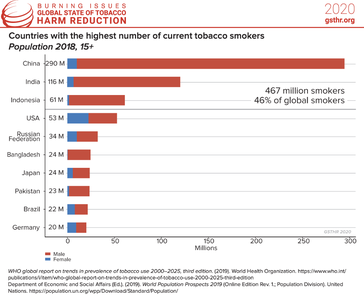Countries With the Highest Number of Current Tobacco Smokers
Countries With the Highest Number of Current Tobacco Smokers
Knowledge•Action•Change (2020)- Burning Issues: The Global State of Tobacco Harm Reduction 2020


This figure illustrates how almost half the world’s smokers (46%) live in just three countries. China has the largest number of current smokers at 290 million, followed by India at 116 million and Indonesia at 61 million. Together, these countries account for 467 million smokers.
Around the world high levels persist, despite major global initiatives led by WHO to reduce smoking – and despite the investment of millions of dollars in tobacco control to reduce the demand for and supply of tobacco (See Chapter 5 of the report: Burning Issues: The Global State of Tobacco Harm Reduction 2020). Average levels of smoking at a national level hide significant differences in the levels of smoking between males and females. Almost one third of men (30 percent) globally smoke compared with 10 percent of women.
According to WHO data for 2018, the prevalence of current tobacco smoking among men in 35 countries is above 40 per cent. This ranges from a staggering 69 percent in Kiribati, to 50 percent in Albania, Cyprus, Kyrgyzstan and Latvia, 45 percent in Greece, Mongolia and Republic of Moldova and 41 percent in Ukraine, the Russian Federation, Bangladesh and Samoa.
In a few high-prevalence countries, the level of female smoking is higher than the male smoking levels found in lower prevalence countries for example, in Kiribati, Nauru, Chile and Serbia, over 40 percent of women smoke compared to 78 other countries where less than 30 percent of men smoke. In some indigenous communities, such as the Māori, more women smoke than men (see Chapter 7 of the report: Burning Issues: The Global State of Tobacco Harm Reduction 2020). There is some evidence that for cultural or social reasons in some countries, there may be under-reporting of female smoking.
For more information see also p.31 of the report: Burning Issues: The Global State of Tobacco Harm Reduction 2020